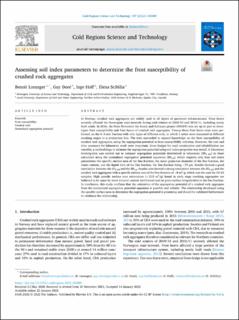| dc.contributor.author | Loranger, Benoit | |
| dc.contributor.author | Doré, Guy | |
| dc.contributor.author | Hoff, Inge | |
| dc.contributor.author | Scibilia, Elena | |
| dc.date.accessioned | 2022-11-30T09:54:19Z | |
| dc.date.available | 2022-11-30T09:54:19Z | |
| dc.date.created | 2022-05-03T12:30:32Z | |
| dc.date.issued | 2022 | |
| dc.identifier.citation | Cold Regions Science and Technology. 2022, 197 . | en_US |
| dc.identifier.issn | 0165-232X | |
| dc.identifier.uri | https://hdl.handle.net/11250/3034958 | |
| dc.description.abstract | In Norway, crushed rock aggregates are widely used in all layers of pavement infrastructures. Frost heave severely affected the Norwegian road network during cold winters of 2009/10 and 2010/11, including newly built roads. In 2016, the Frost Protection for Roads and Railways project (FROST) was set up in part to investigate frost susceptibility and frost heave of crushed rock aggregates. Twenty-three frost heave tests were performed on the 0–4 mm fraction with nine types of different rock, in which 2 series were measured at different crushing stages in a production line. The tests succeeded to expand knowledge on the frost susceptibility of crushed rock aggregates, using the segregation potential as frost susceptibility criterion. However, the cost and time necessary for laboratory work were important. Since budget for road construction and rehabilitation are variable, a methodology to estimate the segregation potential using soil index properties was tested. A laboratory investigation was carried out to compare segregation potentials determined in laboratory (SP0 lab) to those calculated using the normalized segregation potential equations (SP0.n), which requires only four soil index parameters: the specific surface area of the fine fraction, the mean grain-size diameter of the fine fraction, the water content, and the liquid limit of the fine fraction, the fine fraction being <75 μm. Results showed a good correlation between the SP0 lab and the SP0.n. Results also showed a strong correlation between the SP0 lab and the crushed rock aggregates with a specific surface area of the fine fraction of <8 m2/g, which was the case for 19/23 samples. High specific surface area estimations (≈12.5 m2/g) found in early stage crushing aggregates are believed to be cause by weak mineral content enrichment and/or grain-surface irregularities in the fine fraction. In conclusion, this study confirms that the estimation of the segregation potential of a crushed rock aggregate from the normalized segregation potential equations is possible and reliable. The relationship developed using the specific surface area to determine the segregation potential is promising and should be validated furthermore to reinforce the relationship. | en_US |
| dc.language.iso | eng | en_US |
| dc.publisher | Elsevier Science | en_US |
| dc.rights | Navngivelse 4.0 Internasjonal | * |
| dc.rights.uri | http://creativecommons.org/licenses/by/4.0/deed.no | * |
| dc.title | Assessing soil index parameters to determine the frost susceptibility of crushed rock aggregates | en_US |
| dc.title.alternative | Assessing soil index parameters to determine the frost susceptibility of crushed rock aggregates | en_US |
| dc.type | Peer reviewed | en_US |
| dc.type | Journal article | en_US |
| dc.description.version | publishedVersion | en_US |
| dc.source.pagenumber | 12 | en_US |
| dc.source.volume | 197 | en_US |
| dc.source.journal | Cold Regions Science and Technology | en_US |
| dc.identifier.doi | 10.1016/j.coldregions.2022.103489 | |
| dc.identifier.cristin | 2020934 | |
| cristin.ispublished | true | |
| cristin.fulltext | original | |
| cristin.qualitycode | 2 | |

